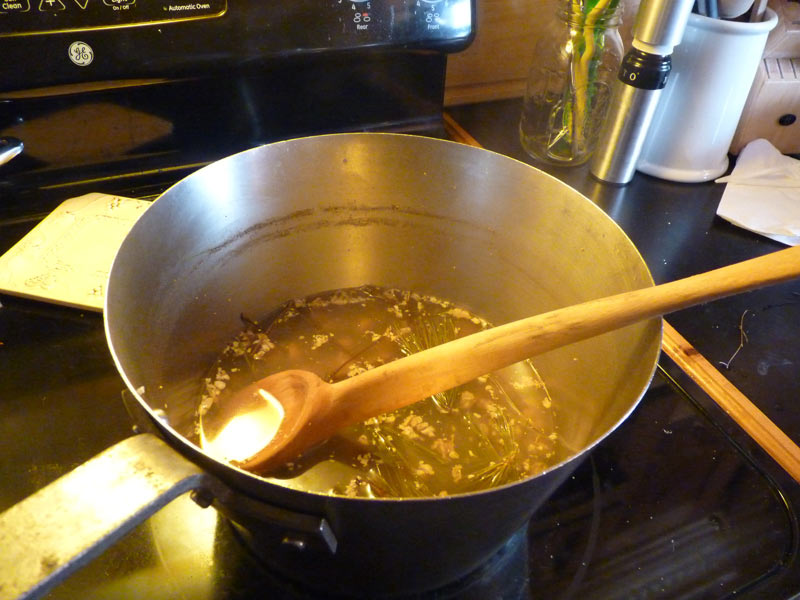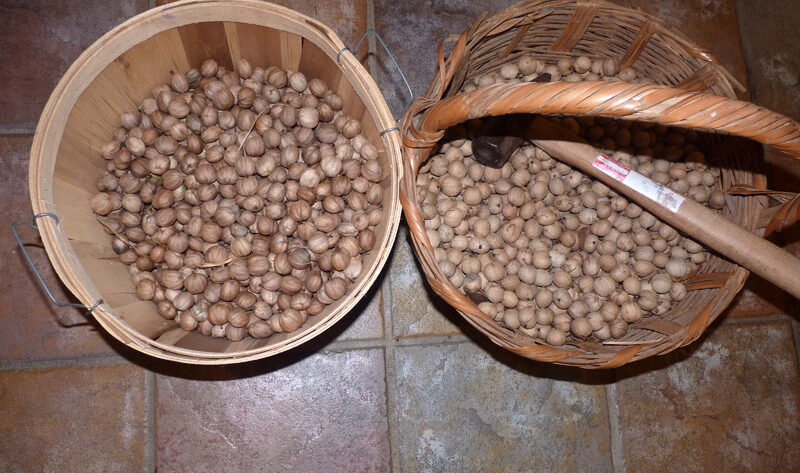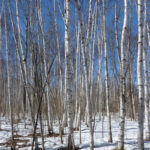There is nothing like an earthy, warm, sweet cup of tea on a cold winter’s night. This recipe is a magical blend, one of the most sacred drinks I have ever enjoyed.
This recipe is derived from an Algonquin recipe that I found in an old book, wanted to try out, and then adapted. It pays homage to the hickory as its star (with birch, pine, and maple as delightful support characters). It’s a perfect drink for Samhuinn, and as the weather grows cold, the plants die off, and the days become dark. It tastes…like nothing else you’ve ever experienced. Slightly piney, slightly minty, very nutty, slightly sweet….all the good flavors in a kind of “tree chai”. I served this at our grove’s Samhuinn ceremony and it was very well received!
I’ve also found this brew to be a most excellent energizing, clearing, and grounding drink. If I’m feeling a bit schizophrenic, trying to balance the demands of the consumerist world that I inhabit and my own spiritual connection to the land (that is being destroyed by that consumerist world), this brew brings me back to where I need to be. It gives me inner peace and grounds me, healing me. This beverage is particularly uplifting if I’m having a difficult day, in need of healing, etc. I think it’s because it has so many good trees with different energies, and they are very balanced. Nature is always a wonderful healer.
1. Obtain your ingredients. For about 6 cups of this brew, you’ll want a handful of white pine needles (without branches), a 6 or so black birch twigs (dried or fresh is fine; I’m using dried cause they are rare around Michigan but bountiful in PA where I gather them when I see my family), hickory nuts (about a cup and a half) and maple syrup (or honey/sugar if you don’t have any). If you don’t have access to any of these ingredients, you can omit them (except the hickory). You can also substitute wintergreen berries or leaves for the black birch and hemlock needles (the tree, NOT the plant) for the pine. But in most Midwestern forests where hickory grows, you should be able to find these.

2. Crush up your hickory. You want to take the outer shell off of your hickory (it’s usually in four or five pieces, easy to peel once the nut dries out for a week or so after it falls from the tree). To make the brew, you want to crush up your nuts (inner shell and all) with a hammer and then throw them into a pot.

3. Add the rest of the ingredients (except maple). Break up your black birch a bit and add your white pine needles to the mix. Add about 6 cups or so of water (more if you want it weaker, less if you want it stronger). I’m making a fairly large batch here, so I added some extra hickory nuts. Extra nuts are always good!


4. Boil for 20-30 minutes. Let the alchemical fires transform your ingredients into a sacred, magical brew. You’ll start to smell it, and then the water will eventually get cloudy as the hickory releases its magic into your tea. The longer you boil it the stronger it tastes. It’s really good. You’ll also notice little oil droplets on the top of the brew–these are from the oil in the hickory nuts, and are full of good nutrients.

5. Strain into cups, add maple syrup to taste, and enjoy! Enjoy one of the most delightful and unique beverages you’ll experience. Use it as a sacred, magical drink for many purposes and share it with friends.



Sounds wonderful!
Yes, indeed! 🙂
Halo. It’s been quite a while since I wrote to you even though I enjoy reading your blog. I have a question concerning your reference to black birch, I’ve lived on the land all my 54 years here on the east coast just across the border from the state of Maine and I’ve never heard tell of Black birch. White birch, yellow birch but nobody in these parts has ever heard of such a variety of birch tree. Can you tell me if any of our native species of birch would work for a substitute? I know from the ancient Gaelic texts dealing with old Irish/Celtic medicine that the yellow birch tree is loaded with the active ingredient in aspirin. The leaves, twigs, an inner bark. This has been confirmed by modern studies. Seems to me it might be what you mid-westerners call black birch. What do you think?
Hi Brent! Great to hear from you again :). I’m actually from PA, so the term “Black birch” comes from there. We don’t have much black birch here in Michigan. What you are going for is the Betula Lenta tree (see Wikipedia entry on it: http://en.wikipedia.org/wiki/Betula_lenta). Its also known as the “sweet birch” tree; and yes, it is a native tree. It contains a lot of methyl salicylate which has a wintergreen taste and smell (this is found on the inner bark of the tree–its light green on the smallest twigs/branches, which is what you want to harvest). Methyl Salicylate was used for aspirin. The Yellow Birch is a different tree (Betula Alleghaniensis) and has methyl Salicylate in much smaller amounts. I haven’t tried it, but it might work. If you can find sweet/black birch, it would work better. I think they should be growing in your area in Maine. Let me know if you need more clarification. And this reminds me that I need to use the Latin names, not the regional names, for plants and trees :).
According to the wiki map for this tree species I live a few hundred miles north of it’s range but thanks for the info Willowcrow. I think I’ll try the yellow birch as a substitute in your recipe. So long.
Brent, does wintergreen grow in your areas? You could use the leaves or berries and get a very similar taste–the wintergreen has the same flavor :).
No it doesn’t at least I’ve never heard of it in northern New Brunswick
Brent – I think its range goes the whole way to Newfoundland. You can find it in dark woods, low to the ground. Here’s more info on it: http://www.hort.uconn.edu/plants/g/gaupro/gaupro1.html
The pics on that site look to me like a plant we call bear berry bushes but I’m not certain. Anyway I am currently working in western Canada forced to work in the dirty oil patch to make enough money to pay off a couple of bills an then convert my place back east to solar and wind power. I already built a rocket stove in my basement and it works great I just have to earn enough to buy some wood.lol
Brent,
I’m sorry to hear about your forced work on the oil patch. I suspect its the same oil patch that is sending oil to pipelines across the area here. But know that you are working towards greater things!!!! I wish you the best of luck–stay in touch and let me know how things go 🙂
It is indeed the same one. I head north tomorrow to some camp that is run by the largest oil company in the world an guess what? It is from China.
Just made this brew tonight is it UNBELIEVABLY good! Thanks 🙂
Glad you enjoyed it! Such a unique flavor… 🙂
Reblogged this on Rattiesforeverworldpresscom.
Do you know the hickory species you use?
Looks kind of like pignut hickory, Carya glabra,
Which is quite bitter.
Can’t really tell though.
Hi soloist! Thanks for the question. Some species are obviously more bitter than others. I’ve used pignut (the ones I had growing in MI were not very bitter but the ones I have in PA are too bitter) and Shagbark Hickory. Bitternuts is always too bitter for this particular recipe. You can test the bitterness by simply cracking them open and eating them–if they taste bitter, they will brew bitter.
I kinda figured as much. Pignut seems the predominant hickory where I am, though I have run across few casings of others but never located the tree.
Gonna have to keep my eyes peeled.
Though I’m going to have to sub for wintergreen, which, I’m not mad about in the slightest…sassafras sounds like a tasty addition too!
You can sub black birch for wintergreen or omit it. I think you can layer other kinds of flavors–I think a small amount of sassafras (as to not overpower the hickory) could be really nice! 🙂